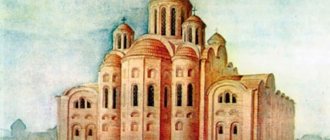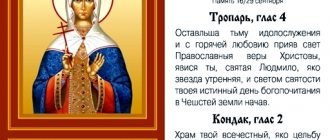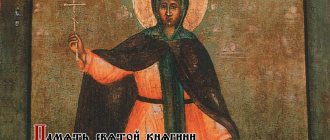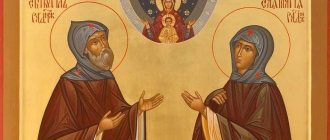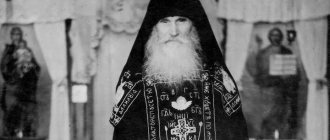Among the first Christians who gave their lives for the Good News was the holy martyr Julia (Julia, that’s how her name is now pronounced). Her icon is now revered throughout the Christian world.
The icon of the saint is revered by both Christians and Catholics. In the small church in Nontse, on the spot where the saint tragically died, there is her icon and part of her relics. The church was consecrated in honor of St. Julia.
Who was Saint Julia
Saint Julia was the daughter of a noble man named Analson. Lived in Carthage, Africa. The saint especially helps those women who bear her name if they resort to her prayerful protection.
There are two types of icons depicting the saint. Orthodox icon, and icon of the Corsican iconographic school. Corsican icons depict Julia as her execution took place. She was crucified and her breasts were cut off during torture. The icon was painted in the 6th century.
In Russia, the icon depicts the saint holding a cross or the Gospel.
Another version
According to the second version, which is also welcomed by the Corsicans, Julia was a native of the city of Nonza and a contemporary of Saint Devota (about 303). For refusing to bow to pagan idols and sacrifice to them, the girl was tortured and then killed. They cut off both her breasts and threw them off a cliff. In the place where they fell, two healing springs opened. After this, the enraged executioners tied Saint Julia to a fig tree, where she died in pain. At this time, a dove flew out of the maiden’s mouth. This moment exactly repeats the previous version of the life of the martyr.
The story of the life and Christian exploit of Saint Julia
Julia was born in Carthage. Since childhood, she was distinguished by piety and loved to read the Holy Scriptures. But trouble loomed over the city. Numerous troops of the Persian king surrounded Carthage. The Persian Vandals who captured the city sold a 10-year-old girl into slavery.
Its owner was the Syrian merchant Eusebius. He convinced the girl to renounce her faith and become a pagan. But she continued to observe Christian customs, praying and fasting.
Julia was very hardworking and did her work conscientiously, so she was sometimes allowed to read the Holy Scriptures. The merchant's wealth increased, trade agreements were concluded easily and successfully completed. The merchant believed that this girl was helping him, bringing him wealth and good luck.
Several years have passed. The merchant went to Gaul to sell his goods there. He took Julia with him as a good luck talisman. During the voyage, the ship made a stop in the city of Nonza, on the island. Corsica. When the ship moored to the shore, its inhabitants were preparing for a pagan holiday. Eusebius was invited to take part in it and sacrifice to idols for further happy voyages and successful trade.
He and his servants went ashore to celebrate, but the girl remained on the ship. Then Julia was already twenty years old. But, at the instigation of demons, one of the pagans entered the ship and saw that there was a girl there. She prayed and grieved for the lost souls. He reported this to the governor.
Felix Saxo (the governor of the island) ordered the merchant to bring the girl to the holiday. He wanted to force her to make a sacrifice to pagan idols. Eusebius said that he wanted to force her to renounce her profession of Christianity, but Julia was adamant.
He then praised her for her hard work and gentleness. The leader of the city ordered the girl to be given to him. But the merchant did not agree. Having drunk the merchant at the feast, the robbers brought Julia by force.
They tried to force the girl to make a sacrifice, promising to free her from slavery for this.
Julia did not agree. She was ready to die, but not to give up her faith. She was brutally abused and eventually crucified on a wooden cross. Before her last breath, Julia said:
The Lord endured torture and mockery, and I will endure it.
She only asked for one thing, that the Lord would give her the strength to endure suffering with dignity and to unite with him in death. The torturers crucified the girl on the cross, like Christ, to whom she so fervently prayed.
At the moment of Julia’s death, a miracle happened: a dove flew from her lips and soared into the sky. The dove in the Christian religion is a symbol of the purity and holiness of the faith. At the command of the Lord, the angels flew to her from heaven at the moment of her death to greet her holy soul with joyful jubilation.
Julia's name day according to the church calendar
Every year Orthodox people celebrate name days. According to the church calendar, the Day of Remembrance of the Holy Patroness Julia is celebrated several times a year.
In common people, name days are also called Angel Day, although there are differences between these days.
Name days are celebrated on the day of remembrance of the Patron Saint, and Angel Day is the day of receiving the Sacrament of Baptism. Orthodox believers attach special significance to these days - just like on their own birthday, they try to confess and take communion, so that the holiday is not only physical, but also spiritual, from unity with the Lord.
- Angel Julia Day
- When is Julia’s name day according to the church calendar?
- Holy Martyr Julia of Carthage, Corsican
- Holy Martyr Julia of Ancyra (Corinth)
- Name day for Julianna and Juliania
Angel Julia Day
So, every person’s Angel Day can happen on any day. Everything will depend on when, in childhood, the child was brought to church to be baptized by his parents.
Believers try to adhere to the ancient tradition of baptizing a child on the 40th day after birth. But some people receive Holy Baptism as adults. So, people with the same names can have their name day on the same day, but Angel Day almost never.
Perhaps it’s useful for everyone to know when Elena’s name day is.
When is Julia’s name day according to the church calendar?
When choosing a name for a child, believing parents themselves choose his Patron Saint. As a rule, this happens even before the baby is born. Parents pray to the Saint, whose name their daughter or son will bear, so that the pregnancy is successful, the birth is successful, and then all their lives they ask the Saint for intercession, protection, and wisdom in raising a pious Christian.
If an adult does not know who his Patron Saint is, he can choose his own Intercessor. This is done simply. For example, an adult girl with the name Julia opens the Orthodox calendar and sees that the name “Julia” is not in the Saints, but there are Saints with the names Julia and Juliania.
The girl reads the lives of all the Saints she can find and chooses the one that is closest to her liking. And then her task will be not only prayer and requests for help in various matters to the chosen Saint, but also veneration - on the days of remembrance you need to attend church, confess and receive communion.
For believers, it is natural to turn daily to their Guardian Angel and Patron Saint in prayer.
Holy Martyr Julia of Carthage, Corsican
Memorial Day is July 29. Several centuries after the Nativity of Christ, the Great City of Carthage was once again treacherously captured and completely destroyed with pagan cruelty. Residents of the city were captured, among them was a small, innocent girl, Julia, ten years old.
In the general mass of people, forced by the pagans, walking far from their places of residence, Julia could not find her parents, friends, neighbors, tears literally consumed her childish face, when suddenly she heard the voice of God: “Blessed are those who mourn, for they will be comforted,” and she calmed down . The girl herself and other captives were taken to Syria, where everyone was sold into slavery. Julia tried not to think about home, prayed a lot and did her work carefully.
Her owner was imbued with bright feelings for her (as far as possible under the slave system) and did not even insist on renouncing Christ. And then one day the slave owner, taking Julia with him, went to travel to distant countries. Sailing past Julia's homeland, the ship, by the will of God, turned to the shores of Corsica, where the feast of the pagan invaders had already begun.
During the festival, the pagans learned that there was a maiden on the ship who was blaspheming their gods, and asked to sell her to them, but the owner refused. Then they, promising Julia freedom from slavery, ordered her to make a sacrifice to their gods. She refused. Immediately a hail of blows fell on Julia; she endured it, just as God endured her.
Having beaten Julia, the pagans crucified her on a wooden cross, as people once did to Christ, but until her last breath the girl was faithful to her faith. After the girl died, a small white bird (soul) flew out of her mouth. Seeing this, the pagans fled in fear and horror.
Soon the monks from Gorgon removed the girl’s body from the cross, and there were legends and legends about her will, loyalty and devotion to Christ. This is the life story of Saint Julia of Carthage, Corsican.
Holy Martyr Julia of Ancyra (Corinth)
Memorial Day is May 31st. The biography of the holy martyr Julia of Ancyra originates in the city of Ancyra (now the territory of Turkey) at the turn of the second and third centuries.
A tough pagan ruler, Theotekn, was appointed to Ancyra, whose main command was that Christians accept pagan sacrifices; in case of refusal, pagan heralds plundered the homes of Christians and destroyed the latter.
However, despite this, Julia of Ancyra, who professes faith in Jesus Christ, did not accept someone else’s faith and did not worship idols. For this refusal, Julia was drowned in the lake along with six saints who accepted martyrdom for Christian ideals.
At the moment, in Orthodox circles it is believed that the icon of Julia of Ankyra and a prayerful appeal to the martyr herself will protect from physical violence. There is also a temple of Julia of Ankyra in the Moscow region.
Name day for Julianna and Juliania
| date | Name Saint | Description of the feat |
| January 3 June 15 | Holy Blessed Princess Juliana of Vyazemskaya and Novotorzhskaya | She was killed by Prince Yuri, who, seduced by the beauty of the girl, wanted to persuade her to commit adultery. Her body floating along the river was seen by a sick peasant, who was immediately healed. Since then, people have come to the princess’s grave, believing in her gracious help. The saint is the patroness and protector of chastity, namely those who lead a monastic lifestyle while in the world. |
| April 2 | Holy Martyr Juliana of Amisia, Pontus | During the time of terrible persecution of Christians under the ruler Maximian, she and other virgins did not renounce their faith in Christ, enduring terrible torment. |
| December 17 | Holy Martyr Juliana of Iliopolis | This happened during the reign of Maximian. Seeing how the pagans were killing the defender of Christ, the Great Martyr Barbara, who openly and fearlessly endured all the torments and was miraculously saved by God, the Christian Juliana declared that she was ready to suffer for Christ. Both martyrs were tortured, beaten and mocked for a long time, but they were strengthened by the power of God. |
| 16th of May | Venerable Juliana of Moscow, Abbess | From early childhood she renounced worldly pursuits, putting in a lot of work to create a monastery in which people strived for Christian ideals. She had a loving and merciful heart, was a comforter, a prayer book, a nurse, a healer of the suffering and sick. |
| January 3 | Holy Martyr Juliana of Nicomedia, Virgin | She accepted torture and death for her unwillingness to change her faith, refusing to marry the pagan Eleusius. Seeing her torture and persistent faith, miraculous healings from wounds, 130 wives and 500 husbands accepted faith in Jesus Christ. |
| March 17 August 30 | Martyr Juliana of Ptolemais | Seeing the suffering of her brother, the martyr Paul, she accused Emperor Aurelian of showing cruelty, for this she was tormented and, together with her brother, accepted martyrdom for faith in Jesus Christ. |
| November 14 | Martyr Juliana of Rossony | Under Emperor Maximian, she was captured and burned for professing the Christian faith. |
| January 15 June 23 July 6 | Righteous Juliana of Lazares, Murom | She distributed her property to the poor, at the cost of her life she saved the lives of loved ones from starvation. |
| July 19 October 11 October 23 | Holy Righteous Virgin Juliania of Olshanskaya, Princess | In the family of the benefactor of the Kiev-Pechersk Lavra, Princess Juliana died at the age of 16. She was buried near the Lavra. Almost half a century later, the incorruptible relics of the Saint were found - in the coffin lay a maiden who seemed to have fallen asleep, decay had not touched either her clothes or her body. Many unimaginable miracles and healings took place at her relics. |
Naming a baby after a Saint is a pious tradition. The saints not only hear us, they see our life, they know what sorrows haunt a person, how the strength in the soul runs out, the body becomes weak and the heart suffers.
The saints pray and intercede for us before the Lord and hear our fervent prayers. Veneration of one’s Saint, imitation of his deeds and faith is the task of every Christian.
Source: //1001molitva.ru/imeniny/yulii.html
Where are the relics of the saint buried?
Not far from o. Corsica is located on. Gorgon. There, in the monastery, an angel appeared, telling the monks of the monastery about the martyrdom of the saint and her feat. The angel ordered to sail to the island, remove the virgin’s body from the cross and bury it in their monastery. Near the tomb of the martyr, miracles of divine help and healing from many diseases began to occur.
From Gorgon the relics were transported to Brescia (Italy). In this city the saint is called in Italian - St. Julia. There is also an Orthodox Church in Brescia. With the permission of the Catholic clergy, at the relics of St. Julia serves prayers for health for Orthodox pilgrims.
Interestingly, the saint’s relics can be seen, as they are kept in a glass tomb under the Catholic altar of the temple.
In the city of Nonza on the island. Corsica, in a small church, rests part of the relics of St. Julia. And now, through the prayers of the saint, miracles of healing continue to occur. There is a holy spring where her severed breasts were thrown. People who drink its healing water with faith miraculously recover.
The Orthodox and Catholic churches celebrate the day of St. Julia of Carthage on July 29 in the new style, and on July 16 in the old style.
Angel Julia Day
So, every person’s Angel Day can happen on any day. Everything will depend on when, in childhood, the child was brought to church to be baptized by his parents.
Believers try to adhere to the ancient tradition of baptizing a child on the 40th day after birth. But some people receive Holy Baptism as adults. So, people with the same names can have their name day on the same day, but Angel Day almost never.
Prayer
Oh, beloved of Christ, wonderful virgin Julia, you endured many sorrows from a small age. Having been in slavery to the tongue, you remained faithful to Christ. She was not afraid of threats and did not succumb to seduction.
Having maintained spiritual and physical purity, standing at the throne of the Lord, help us sinners who ask for your help to maintain purity and chastity. Having been tormented by evil tongues, you suffered until death. Deaths on the cross.
Pray to the All-Merciful Savior to strengthen our faith and to send us patience in our sorrows! Having received grace from God to bestow healing on the sick, do not despise us sinners who ask for your help. Give us healing in our ills.
Rejoice, great wonderworker, martyr Julia! Lamb of Christ, pray to God for us! Amen.
Interesting Facts
The city of Sainte-Julie in Canada, Quebec, is named after Saint Julia of Carthage. An asteroid that was discovered in 1866 is also named after her.
In the Orthodox tradition, another martyr named Julia is venerated. She is one of the seven holy virgins who were drowned in the lake after cruel torture for the faith of Christ. Later their bodies were burned by the pagans. The saint is called Ancyra (or Corinth) after her place of birth. Her memory day is celebrated on May 31 and November 19 according to the new style.
In the 7th-8th centuries. The church at the burial site of the martyr fell into disrepair and was partially destroyed. The inhabitants of Corsica decided to build a new temple in honor of Saint Julia. They collected stones, sand, bricks and left them in the place they chose to erect the building. But on the night before the foundation was laid, someone’s invisible hand carried all the materials to the foot of the old church. Perplexed, people returned everything to a new place. But the next night the same thing happened. According to legend, watchmen watched as the bright maiden transported materials on white oxen. People realized that Saint Julia did not want the temple to be built in a new place. Therefore, the place of her burial was cleared and a new church was erected in honor of the martyr.


